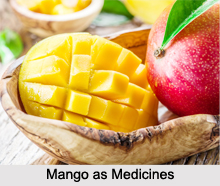 Mangifera Indica, also known as Mango, has been an important herb in the Ayurvedic and indigenous medical systems for over 4000 years. According to Ayurveda, varied medicinal properties are attributed to different parts of mango tree.
Mangifera Indica, also known as Mango, has been an important herb in the Ayurvedic and indigenous medical systems for over 4000 years. According to Ayurveda, varied medicinal properties are attributed to different parts of mango tree.
Mango is well known as the most delicious of Indian fruits. The ripe fruit is somewhat laxative and useful to persons of constipated habits. The bark and kernel are regarded as astringent and useful in haemorrhages, diarrhoea and other discharges.
In diarrhoea, a decoction of the kernel is given alone or in combination with bela and ginger. In bleeding from the nose, the juice of the kernel is recommended to be snuffed. In bleeding from internal organs, a cold infusion of the barks of Mangifera Indica, Eugenia Jambolana and Terminalia Arjuna is prescribed. This infusion is also used in diarrhoea. The Bhabaprakasa recommends a confection made of the juice of the ripe mango, sugar and aromatics, for use as a restorative tonic.
This article is a stub. You can enrich by adding more information to it. Send your Write Up to content@indianetzone.com
Related Articles
History of Ayurveda
Origin of Ayurveda
Ayurveda Medication
Elements of Ayurveda
Concepts of Ayurveda
Ancient Literature of Ayurveda




















